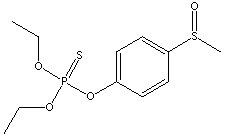Fensulfothion
- O,O-Diethyl O-(p-methylsulfinyl)phenyl)phosphorothioate

Fensulfothion | |
| |
| Formula | C11H17O4PS2 |
| Structure |  |
| Description | Oily yellow or brown liquid. |
| Uses | Insecticide, nematicide. |
| Registry Numbers and Inventories. | |
| CAS | 115-90-2 |
| EC (EINECS/ELINCS) | 204-114-3 |
| EC Index Number | 015-090-00-7 |
| EC Class | Very toxic; Dangerous for the Environment |
| RTECS | TF3850000 |
| RTECS class | Agricultural Chemical and Pesticide; Mutagen |
| UN (DOT) | 3017 |
| Merck | 12,4042 |
| Beilstein/Gmelin | 2219515 |
| EPA OPP | 32701 |
| Swiss Giftliste 1 | G-4104 |
| Austrailia AICS | Listed |
| Properties. | |
| Formula | C11H17O4PS2 |
| Formula mass | 308.36 |
| Boiling point, °C | 138 |
| Vapor pressure, mmHg | 5E-5 |
| Density | 1.202 g/cm3 (20 C) |
| Solubility in water | 2 g/L |
| Partition coefficient, pKow | 2.23 |
| Hazards and Protection. | |
| Storage | Keep in well-ventilated area. Protect against physical damage. Store at in areas where any spillage would not endanger workers or contaminate materials. |
| Handling | All chemicals should be considered hazardous. Avoid direct physical contact. Use appropriate, approved safety equipment. Untrained individuals should not handle this chemical or its container. Handling should occur in a chemical fume hood. |
| Protection | Chemical splash goggles in compliance with OSHA regulations are advised; however, OSHA regulations also permit other type safety glasses. Whre chemical resistant gloves. To prevent repeated or prolonged skin contact, wear impervious clothing and boots. |
| Respirators | Must wear a respirator with an activated-carbon gas filter cartridge affording protection for a determined number of working hours. |
| Small spills/leaks | (Non-Specific -- Organophosphorus Pesticide, Liquid, n.o.s.) Keep unnecessary people away; stay upwind. Do not touch spilled material; stop leak if possible. Use water spray to reduce vapors. Take up with noncombustible absorbent material. For large spills, dike far ahead of spill. |
| Stability | Like parathion, fensulfothion may decompose at elevated temperatures and rupture containers violently. |
| Incompatibilities | Avoid contact with alkalis |
| Decomposition | When heated to decomposition, it emits very toxic fumes. |
| Fire. | ||||
| Fire fighting | (Non-Specific -- Organophosphorus Pesticide, Liquid, n.o.s.) Wear positive pressure breathing apparatus and special protective clothing. Move container from fire area. Fight fire from maximum distance. Dike fire control water for later disposal; do not scatter the material.Extinguish with dry chemical, carbon dioxide, water spray, fog or foam. | |||
| Health. | |
| Exposure limit(s) | NIOSH REL: TWA 0.1 mg/m3 |
| Poison_Class | 1 |
| Exposure effects | Reduced body temperature or elevated body temperature may occur. Low heart rate and abnormally low blood pressure may develop after moderate to severe poisoning. Rapid heart rate, elevated blood pressure, and changes in respiratory rate may also occur. Early giddiness, anxiety headache, and restlessness followed by ataxia, drowsiness, and confusion are common with moderate to severe exposures. Sporadic reports of human birth defects related to organophosphates have not been fully verified. |
| Ingestion | Vomiting, hypersalivation, diarrhea, fecal incontinence and abdominal pain may occur. |
| Inhalation | Dyspnea, rales, bronchorrhea, bronchospasm, or tachypnea may be noted. Noncardiogenic pulmonary edema may occur in severe cases. Chemical pneumonitis may be seen. |
| Skin | Sweating is a consistent but not universal sign. |
| Eyes | Constriction of the pupil, tearing, and blurred vision are common. Prolonged dialation of the pupils may occur in severe poisonings. Opsoclonus has been reported in one case. Salivation commonly occurs. Rhinorrhea may occur. |
First aid |
|
| Ingestion | Seek medical attention. If individual is drowsy or unconscious, do not give anything by mouth; place individual on the left side with the head down. Contact a physician, medical facility, or poison control center for advice about whether to induce vomiting. If possible, do not leave individual unattended. |
| Inhalation | If symptoms develop, move individual away from exposure and into fresh air. If symptoms persist, seek medical attention. If breathing is difficult, administer oxygen. Keep person warm and quiet; seek immediate medical attention. |
| Skin | Remove contaminated clothing. Wash exposed area with soap and water. If symptoms persist, seek medical attention. Launder clothing before reuse. |
| Eyes | If symptoms develop, immediately move individual away from exposure and into fresh air. Flush eyes gently with water for at least 15 minutes while holding eyelids apart; seek immediate medical attention. |
| Transport. | ||
| UN number | 3017 | |
| Response guide | 131 | |
| USCG CHRIS Code | FFT | |